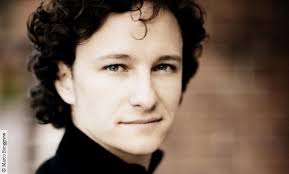Marlowe Theatre Canterbury, 4 May 2016
The structure of this concert reminded me of a water hole on an African safari. First came Mozart, light footed like a gazelle, then Beethoven arrived, giraffe like, with elegance, panache and beauty, then finally we got Elgar – colossal, like an elephant but with all the delicacy and sensitivity of a highly intelligent animal.
To this, Edward Gardner, assisted by the Marlowe Theatre’s acoustic which is surprisingly good for a dual purpose performing space, found unusual clarity in the music. With second violins facing the firsts, and cellos and violas tucked between them, the balance worked beautifully especially in the light semi quaver passages in the overture to The Magic Flute, although I have reservations about hearing Mozart overtures in concerts. They always leave me aching for curtain up and the rest of the opera.
 played Beethoven’s second piano concerto with intensity but without gratuitous flamboyance, although his left foot seems to have an independent life of its own, shaking and tapping. He packed plenty of brio into the fortissimo development passages in the allegro and played the adagio with much gentle eloquence. The triplets, which tumble playfully over the brass and woodwind interjections, were especially fine in the adagio. So was the control with which Helmchen and Gardner bounced, attacca, out of the adagio into a spirited account of the rondo which tripped away with plenty of verve and wit.
played Beethoven’s second piano concerto with intensity but without gratuitous flamboyance, although his left foot seems to have an independent life of its own, shaking and tapping. He packed plenty of brio into the fortissimo development passages in the allegro and played the adagio with much gentle eloquence. The triplets, which tumble playfully over the brass and woodwind interjections, were especially fine in the adagio. So was the control with which Helmchen and Gardner bounced, attacca, out of the adagio into a spirited account of the rondo which tripped away with plenty of verve and wit.
The busy, awkward opening of Elgar’s second symphony came off fairly well although I have a feeling that had this been a rehearsal they might have done it again. High spots included the richly melodious string work in the larghetto, incisive “conversations” between sections in the rondo and the sustained drama of the final chords as they die away at the end of the final movement. Gardner resisted the urge to milk Elgar’s favourite instruction “noblimente” too much and although it was a rendering with plenty of heart it was also crisp and clearly defined.
Two more general points strike me. First, the Marlowe’s playing space is large enough for a classical orchestra plus piano but only just. It’s a tight squeeze in some sections and when the orchestra was augmented with the extra brass, woodwind and percussion for the Elgar and the 20th century it took really careful stage management. Second, did Gardner forget his outfit and have to pop into Canterbury to buy a cheap off-the-peg suit in the afternoon? He really looked very odd in a dark suit which didn’t fit properly when everyone else, even the soloist, was in tails.
Susan Elkin
